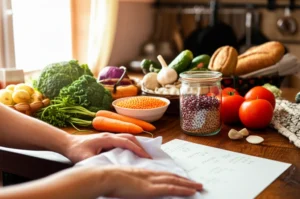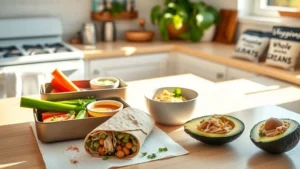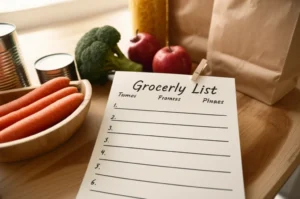At first, I thought saving real money at the grocery store was basically impossible. Like, every time I tried to tighten my belt, something snuck into my cart—a random bag of chips, “premium” cheese, or those $6 pints of fancy ice cream that call to you in the freezer aisle (don’t judge…). But what if I told you grocery shopping tips could actually make a huge difference—even if, like me, grocery stores sometimes feel like obstacle courses designed to trip up your wallet?
I’ve been there: the failed “no-spend” challenges; the spaghetti-for-days meal plans; the kids giving me side-eye for not buying name-brand cookies. But with some friendly tweaks and a little resourcefulness, I promise there’s a path to saving money, eating better, and feeling way less stressed on your next grocery run. Ready? Let’s see how real humans (not robots) save big, without sacrificing flavor or fun.
Plan Like a Pro
Why Do I Always Overspend?
Ever walk into a store with no plan… and walk out with $100 of snacks and, like, half a dinner idea? Yeah, same. The magic starts at home—take a quick look in your pantry and freezer (and really look, not just the front row of stuff). Check for those “mystery cans” and what’s about to expire. You’ll be shocked how often you already own dinner’s main ingredients—or a whole week’s worth, tucked behind the cereal.
Easy At-Home Pantry Hacks
- Keep a running list on your fridge door—if you run out of something, write it down right away. It helps you avoid that awkward third trip back for eggs on a busy weeknight.
- Do a ten-minute “pantry cleanout” before shopping—group canned goods, grains, and odds-and-ends, and make notes about what you should actually use up.
Okay, once you know what you have, start filling in the blanks with what’s missing. I love planning 5–7 simple meals using overlap ingredients. Why? Well, if I buy a giant bag of carrots or a rotisserie chicken, I want to use it up, not let it wilt away in the veggie drawer.
If you want a cheat sheet, check out Tips for grocery shopping on a budget. Seriously—it’s full of those “duh, why didn’t I think of that?” ideas to keep your cart focused and your mind calm.
Trying a Weekly Menu (Is It Weirdly Game-Changing?)
Confession time: I used to think weekly menus were for ultra-organized people. Turns out, they’re for anyone who doesn’t love standing in a store, Googling “What can I make with half a zucchini and rice?” at 6pm. When you sit down and jot out your dinners for the week—using what’s already in your kitchen—everything just… gets easier.
Sample Budget Menu for the Real World
| Day | Meal Idea | Money-Saving Angle |
|---|---|---|
| Monday | Stir-fried veggies with rice | Use up veggie odds-and-ends |
| Tuesday | Lentil soup and crusty bread | Dried beans are cheap protein |
| Wednesday | Chicken wraps with leftover veggies | Stretch one protein over two meals |
| Thursday | Egg fried rice with frozen peas | Eggs and rice: budget heroes |
Personal tip: I once did a pantry challenge where I limited myself to three fresh groceries each week for a month… and it forced me to get inventive (and finally use up that can of pumpkin from 2020). Try it—you might just discover a new favorite recipe or two.
Store Navigation Secrets
Where’s the Smartest Place to Start?
Let me guess: you walk into the store, get lured by that mountain of chips and soda, and by the time you get to the produce section, your cart is already fuller than planned. Here’s the big grocery shopping tip: stick to the outer aisles first. Most fresh stuff—produce, dairy, meat, eggs—lives there. Inner aisles are like the snack-y Wild West. Venture in only with purpose.
Perimeter Picks (Aisle Avoidance Edition)
- Fresh or frozen produce: Frozen fruits and veggies are as nutritious as fresh, last longer, and are way less likely to turn into science experiments in your fridge.
- Whole grains in bulk: Oats, brown rice, and barley are super cheap—but don’t get distracted by all the “fancy” pre-mixed packages inside the aisles.
- Lean proteins: Stock up on chicken thighs, beans, and tofu. Extra points for local sales or farmers markets if you have one nearby (the flavor difference in in-season produce is real).
Little story: I switched to shopping the perimeter and skipping the snack aisle unless I had a specific treat on my list. Suddenly… no more $18 impulse cookie sessions. You can always sneak one or two “fun snacks” on your list, just, you know… maybe not a dozen.
Do You Shop Hungry? (Spoiler: Don’t!)
I swear, the worst financial decisions happen when you’re hungry and rushing. Every bag of candy and salty snack yells your name. Eat before you go—it’s a classic tip, but honestly, it’s saved me from about a hundred “regret buys.” If you’re like me and shop with kids, bring a small snack for them too, or that checkout line chocolate WILL end up in your cart (and your budget in the trash).
Timing Tricks for Sanity
- Shop mid-week or early morning if you can: Less crowd means less stress, and shelves are better stocked. (Fewer impulse buys, too!)
- Try to limit grocery trips to once a week. The more often you go, the more you spend—trust me.
Healthy Cart, Happy Wallet
Can You Eat Healthy, Cheap?
Here’s the truth: better eating doesn’t mean you have to “go gourmet”… or blow your budget. In fact, a healthy grocery list on a budget usually just means basic, wholesome staples—whole grain bread, canned beans, frozen spinach, bananas. Simple stuff. Swap processed foods for real foods (think: beans instead of hot dogs) and you’ll save on both cash and health bills down the line.
Don’t miss this Healthy grocery list for weight loss—it’s loaded with ideas that work whether you’re trying to eat lighter or just want more mileage from every dollar. Savvy shopping means checking ingredients lists (real food first!) and learning where hidden costs lurk (spoiler: tiny pre-made snack packs).
Label-Reading Ninja Moves
- Look for short ingredient lists where whole foods top the list. (If sugar or hydrogenated whatever shows up first? Back on the shelf it goes.)
- Compare “unit prices” on shelf tags—not just sale prices. That huge bag of oats? Often cheaper per serving than a six-pack of individual portions.
- Ignore front-of-package marketing. Instead, flip, read, and decide for yourself.
And if you want a real-life “budget vs. splurge” comparison… here’s a quick table that shows why sometimes the basics win hands down:
| Item | Budget Pick | Splurge | Savings |
|---|---|---|---|
| Protein | Canned beans ($1/can) | Pre-marinated chicken ($6/pkg) | Beans: less waste, more uses |
| Grains | Bulk oats ($2/lb) | Instant oatmeal packets ($4/box) | Bulk: $ down, sugar down |
| Produce | Frozen veggies ($2/bag) | Berry medley cups ($7/carton) | Frozen beats fresh out-of-season |
Grabbing these staples helps keep your healthy grocery list on a budget realistic, filling, and way less fussy than Instagram would have you think.
Is Seasonal Really Cheaper?
Yes, yes, YES. I used to be skeptical, but buying what’s in season locally is one of the best grocery shopping tips for slashing costs… and improving taste. Fresh zucchini or tomatoes in summer? Crazy cheap, super flavorful. Strawberries in February? Your wallet (and the planet) will not thank you. Hit up farmers markets or just scan your store’s flyers for the week’s produce specials.
Here’s my favorite money-saving trick: When apples go on sale, I’ll buy a big bag and slice/freeze extras for smoothies or baking later. It’s not about being perfect; it’s about picking your spots and scoring easy wins. That’s what makes a healthy grocery list for weight loss stick even on tight weeks.
Want more? See what’s on the healthy grocery items guide—sometimes, the best deals are the simplest.
Real-World Savvy Shopper Stories
How I Turned Regret Buys into Save-Buys
Story time: Once, I shopped hungry after work. My “healthy” intentions vanished somewhere between the cheese aisle and bakery. I left with two loaves of artisan bread, three different dips, and zero dinner ingredients. By Friday, all I had was a weird memory of snacking and an empty fridge. I needed a better system.
So I tried actually using a healthy grocery list on a budget. I planned simple meals, stuck (mostly) to my list, and started buying store brands. Some weeks, I even batch-cooked—a giant pot of chili stretched over three meals, with leftovers for work lunches. Things weren’t always neat, but my bank account thanked me. And—bonus!—nobody missed the “fancy” snack packs.
More Tips, Less Stress
- Set a spending target before leaving home. Track with your phone calculator as you shop, rounding up for a “bonus buffer.”
- Join your supermarket’s rewards programs and actually use the points. A little payoff here and there really adds up.
- Never feel weird about putting something back at checkout if you change your mind! We’ve all done it (politely, of course).
Grocery shopping tips aren’t just about headline savings; sometimes, it’s the tiny swaps—bulk oats over single-serve packs, or frozen spinach instead of pricey bagged salads—that make the biggest difference in both money and meal variety.
Conclusion: Your Frugal Food Future Awaits
So, here’s the bottom line: Grocery shopping doesn’t have to feel like a battle between your cravings and your bank account. Small, practical tricks really do stack up… Use what’s already in your pantry, give a simple meal plan a try, shop the perimeter, and be brave enough to ignore those flashy impulse buys. Choose frozen or in-season produce when the price is right. Lean in on a healthy grocery items list: You’ll eat better and keep more cash for what really matters (treat yourself, or maybe just a solid emergency fund for next month’s surprises).
You don’t need to overhaul your life overnight. Just pick one new tip to try—maybe checking the fridge before you shop, or grabbing a Healthy grocery list for weight loss for inspiration. Your future self (and your wallet) will be high-fiving you before you hit the parking lot. Promise.
If you find a tip that totally changes the game, share it! We’re all figuring this out together, one grocery run at a time. Here’s to full carts, full bellies, and a few more bucks left over for the fun stuff. Go on—give these a shot and let me know how it goes. You got this.













